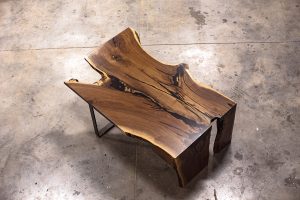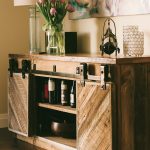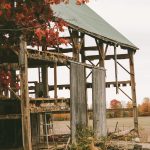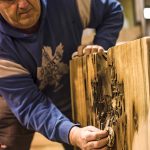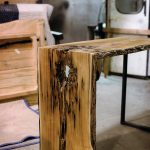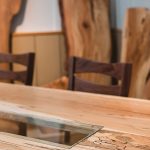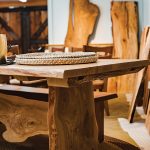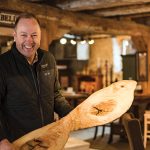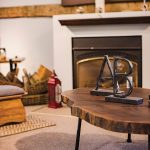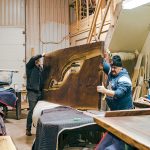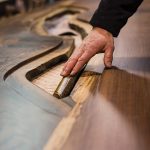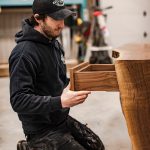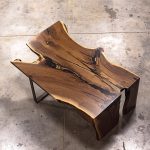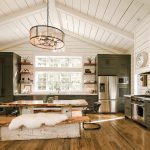Natural wood furniture is rustic, unique and growing in popularity
by Janet Lees
photography by Jessica Crandlemire
Natural wood furniture has come a long way over the past 50 years, and in its latest guise it boasts a rustic chic vibe that puts the emphasis firmly on “chic.” From one-of-a-kind live edge tables crafted from salvaged trees, to contemporary reclaimed barn board pieces styled and finished to suit any taste, today’s solid wood furniture has all the ‘wow’ factor of a walk in the forest.
Live Edge
We don’t often think of furniture as art, but a well-crafted live edge dining table or coffee table definitely qualifies. The rich contours of the natural edges give each piece a sculptural quality that makes a statement in any room.
Live edge or natural edge refers to a style of furniture that incorporates the irregular edge of the wood into the design. In most cases, the rough, thick texture of the tree’s surface is still visible instead of being squared off, so that what you see is literally a slice of a tree. Live edge furniture often incorporates gnarly wood and leaves the natural holes, knots, worm tracks and imperfections in place to maintain the tree’s unique character.
“It’s a true conversation piece; a beautiful piece of furniture that’s going to last a lifetime,” says Wayne Datema, owner of Country Charm Mennonite furniture in Owen Sound.
“It’s furniture your grandchildren are going to fight over some day.”
Customers can choose from hand-crafted live edge pieces or browse the large selection of slabs in a variety of woods to create their own custom-designed piece. All of the wood is harvested sustainably in Ontario, in many cases using fallen, dead or diseased trees and in others replanting several new trees to replace each harvested tree. Datema says he personally chooses the wood for the live edge pieces, adding he only uses domestic wood so he can verify that it has been sustainably cut.
“When it comes to live edge, customers love to listen to the story behind the tree. They like to know where it comes from,” he says.
One of his favourite woods is spalted maple, which comes from a maple tree that has died and is beginning to rot. “The rot lines make incredible patterns on the furniture,” he notes. “The trick is to retrieve these trees before they get too punky.” Another favourite is butternut, which can only be cut by permit as it is now on the endangered list. “We only use the ones that have already died,” he says. “We have some pieces where you can see the incredible channels eaten by bugs when the tree was still standing.
“We even had a beautiful piece made from iron wood, one of our hardest domestic woods; it can easily cause sparks when cutting it. We also love to find burls, large or small. A burl is a growth or lump in the tree caused by uncontrolled cell division (sometimes called ‘tree cancer’). This growth can make beautiful grain patterns and colours.”
The wood is kiln dried to reduce the moisture content and stop any rot or disease process. The pieces are hand-made by Amish or Mennonite craftsmen, then finished by Country Charm in a variety of stains and finishes. Knots and holes may be left as-is or filled with resin, depending on their size and location. The end result is a statement piece that is as functional as it is artistic.
“The irregularities in the wood don’t make it weaker; they just make it more interesting,” says Datema, adding, “The key is to make sure it’s kiln dried to the right level; that is absolutely critical.” Using domestic woods also ensures that once the piece is finished, it will hold up to our varied Canadian humidity levels without splitting or cracking.
For Adam Garbutt of AG Designs in Collingwood, it can take several years for a piece of wood to go from tree to table. He uses wood that is salvaged, milled and air dried for two years. “From there it goes into a kiln for a few weeks to bring the material to a proper moisture content, so that when you put it in your house it’s already somewhat acclimatized to your moisture content.”
The term “live edge” can be confusing, he says, because it doesn’t necessarily mean the tree was alive when it was harvested. “Most of our live edge furniture comes from old fence rows where the trees have fallen over or they’re kind of rotten and we go in and salvage the bottom trunk of it. We don’t go and cut down a live tree.”
Both Garbutt and Datema point to an increase in popularity of live edge furniture. “We only started doing live edge a few years ago, and I would say that today about 25 to 30 per cent of our sales would include a live edge piece,” says Garbutt. Adds Datema, “It’s not just fashionable, because with live edge furniture, the piece you will have is truly one-of-a-kind; no one else will have the same piece. So it’s more of a long-term thing than a trend. And live edge really stands out beautifully in a very modern, contemporary home.”
Rustic & Reclaimed
In addition to live edge accent pieces, rustic furniture is gaining a permanent foothold in every room of the house, from bedroom sets to barn doors, hutches, media cabinets and even built-ins.
“This isn’t traditional country furniture,” says Datema. “This is modern rustic furniture that works well in any home to add character and make a statement.” As with live edge pieces, in many cases the story behind the wood is as interesting as the design of the furniture.
“We feature many pieces made with reclaimed lumber from old barns,” says Datema. “We even have tables made from Douglas fir salvaged from the Welland Canal, showing the dark water stains and oversized holes where it was bolted to the walls of the canal.”
Garbutt started AG Designs 15 years ago, taking down old barns and selling the wood for flooring and other uses. Today he has a 4,000-square-foot shop and three full-time craftsmen building furniture out of barnboard.
“When I first started making furniture, my market was 95 per cent in the city, but over the last five years it has become more and more popular in our area, and now I would say 90 per cent of our work is going to homes within half an hour to an hour of Collingwood.”
Garbutt and his team still dismantle old barns themselves, making furniture from the barn flooring and “grey board” (exterior barn board) and using the beams in ceilings and mantles.
“Our clients really like the idea of having something recycled in their home, and they’re often amazed at how versatile reclaimed wood is. We can go with any design or décor that our clients are trying to add to their space, we can make it more rustic or less rustic, and we can mix in modern wood, too.”
He adds customers like the idea of authentic, environmentally friendly furniture that doesn’t skimp on style.
“It’s not like an assembly line. Each piece of furniture we make is completely custom and timeless. You’re getting a piece of furniture that is built out of real, solid wood and you’re recycling the wood, so there’s a lot to feel good about.”
Both Garbutt and Datema advise those thinking of buying reclaimed or live edge wood furniture to do their homework and ask for referrals. “This is not cheap stuff – these are investment pieces, heirloom pieces, and you definitely want to make sure you get what you’re paying for,” says Garbutt. Adds Datema, “I love the variety of what we can do. I love getting calls from customers who are ecstatic about a recent delivery and say they love the piece more in their place than they imagined it would look.”
Today’s natural wood furniture is stylish, sleek and contemporary – a far cry from the rough-hewn, bulky log-framed pieces of your grandmother’s rec-room or your childhood cottage. You might even say it’s a little bit country, a little bit rock ’n’ roll. ❧






